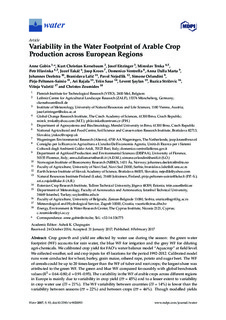| dc.contributor.author | Gobin, Anne | |
| dc.contributor.author | Kersebaum, Kurt Christian | |
| dc.contributor.author | Eitzinger, Josef | |
| dc.contributor.author | Trnka, Miroslav | |
| dc.contributor.author | Hlavinka, Petr | |
| dc.contributor.author | Takác, Jozef | |
| dc.contributor.author | Kroes, Joop | |
| dc.contributor.author | Ventrella, Domenico | |
| dc.contributor.author | Marta, Anna Dalla | |
| dc.contributor.author | Deelstra, Johannes | |
| dc.contributor.author | Lalic, Branislava | |
| dc.contributor.author | Nejedlik, Pavol | |
| dc.contributor.author | Orlandini, Simone | |
| dc.contributor.author | Peltonen-Sainio, Pirjo | |
| dc.contributor.author | Rajala, Ari | |
| dc.contributor.author | Saue, Triin | |
| dc.contributor.author | Saylan, Levent | |
| dc.contributor.author | Stricevic, Ruzica | |
| dc.contributor.author | Vucetic, Visnja | |
| dc.contributor.author | Zoumides, Christos | |
| dc.coverage.spatial | Europe | nb_NO |
| dc.date.accessioned | 2018-07-25T13:58:28Z | |
| dc.date.available | 2018-07-25T13:58:28Z | |
| dc.date.created | 2017-09-29T14:39:18Z | |
| dc.date.issued | 2017-02-08 | |
| dc.identifier.citation | Water. 2017, 9 (2), . | nb_NO |
| dc.identifier.issn | 2073-4441 | |
| dc.identifier.uri | http://hdl.handle.net/11250/2506496 | |
| dc.description.abstract | Crop growth and yield are affected by water use during the season: the green water footprint (WF) accounts for rain water, the blue WF for irrigation and the grey WF for diluting agri-chemicals. We calibrated crop yield for FAO’s water balance model “Aquacrop” at field level. We collected weather, soil and crop inputs for 45 locations for the period 1992–2012. Calibrated model runs were conducted for wheat, barley, grain maize, oilseed rape, potato and sugar beet. The WF of cereals could be up to 20 times larger than the WF of tuber and root crops; the largest share was attributed to the green WF. The green and blue WF compared favourably with global benchmark values (R2 = 0.64–0.80; d = 0.91–0.95). The variability in the WF of arable crops across different regions in Europe is mainly due to variability in crop yield (cv = 45%) and to a lesser extent to variability in crop water use (cv = 21%). The WF variability between countries (cv = 14%) is lower than the variability between seasons (cv = 22%) and between crops (cv = 46%). Though modelled yields increased up to 50% under sprinkler irrigation, the water footprint still increased between 1% and 25%. Confronted with drainage and runoff, the grey WF tended to overestimate the contribution of nitrogen to the surface and groundwater. The results showed that the water footprint provides a measurable indicator that may support European water governance. | nb_NO |
| dc.description.abstract | Variability in the Water Footprint of Arable Crop Production across European Regions | nb_NO |
| dc.language.iso | eng | nb_NO |
| dc.publisher | MDPI AG, Basel, Switzerland | nb_NO |
| dc.rights | Navngivelse 4.0 Internasjonal | * |
| dc.rights.uri | http://creativecommons.org/licenses/by/4.0/deed.no | * |
| dc.subject | water footprint | nb_NO |
| dc.subject | arable crops | nb_NO |
| dc.subject | cereals | nb_NO |
| dc.subject | crop water use | nb_NO |
| dc.subject | yield | nb_NO |
| dc.title | Variability in the Water Footprint of Arable Crop Production across European Regions | nb_NO |
| dc.type | Journal article | nb_NO |
| dc.type | Peer reviewed | nb_NO |
| dc.description.version | publishedVersion | nb_NO |
| dc.rights.holder | © 2017 by the authors; licensee MDPI, Basel, Switzerland | nb_NO |
| dc.source.pagenumber | 22 | nb_NO |
| dc.source.volume | 9 | nb_NO |
| dc.source.journal | Water | nb_NO |
| dc.source.issue | 2 | nb_NO |
| dc.identifier.doi | 10.3390/w9020093 | |
| dc.identifier.cristin | 1500536 | |
| cristin.ispublished | true | |
| cristin.fulltext | original | |
| cristin.qualitycode | 1 | |

